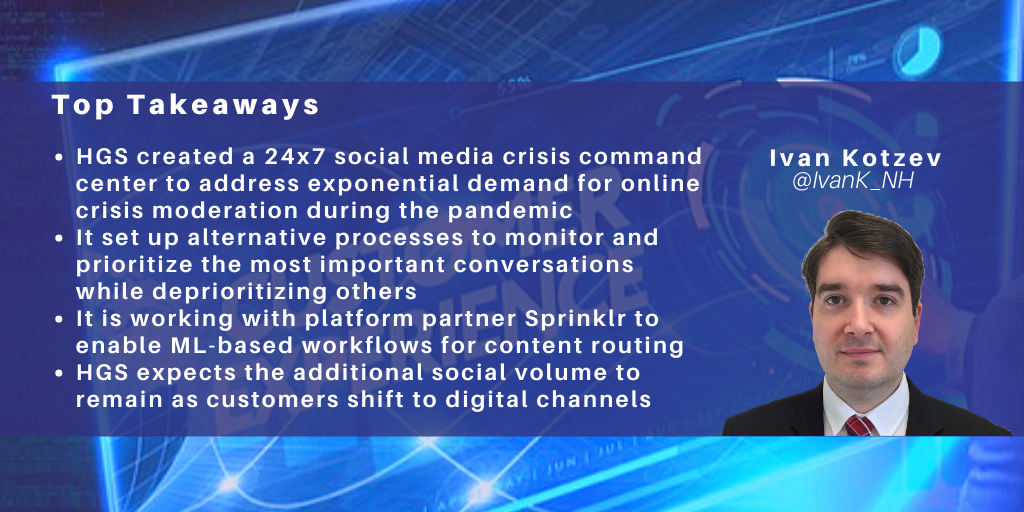posted on Aug 28, 2020 by Ivan Kotzev

Ages ago, in the pre-COVID-19, pre-U.S. election, pre-BLM protest times of 2019, the challenges of online reputation management (ORM) seemed to be brand-specific. For example, how Boeing could restore customer confidence in the 737 MAX aircraft. Today, in the second half of 2020, navigating social media during a crisis is top of mind for most brand managers and PR departments across industries and markets. The onslaught of economic, political, and social changes is pushing corporations to build real-time crisis management capability proactively, often starting with online, as users are firmly embedded in the digital world.
HGS crisis command center
In Q2 2020, HGS created a 24x7 social media crisis command center in Mumbai, India, with 200 social media analysts, of which ~90% are working from home. The team consists of four types of roles: customer care, joy and revenue generation, issues and escalations, and reporting and insights. The center addressed an exponential client demand for online crisis moderation during the pandemic. The team monitors in real-time owned and earned media for its social media clients, covering mentions of the brand, key executives, employee related conversations, and competitor posts. The last one helps identify and create alerts for emerging market-wide issues or industry problems before they affect the client.
It has algorithms monitoring thresholds for topics reaching viral status or beginning to trend in a viral pattern. The team follows the topic through its full course, captures the context, and alerts the brand. It also trains the ML algorithms with new keywords to listen to and calibrate the required thresholds; for example, 1k interactions in the first 15 minutes.
In March 2020, HGS reached out proactively to its clients to jointly plan investments in social media resources and licenses. It defined the required analytics and insights to drive decision making by brand managers and marketers. Further, it prepared workflows to distribute content such as ethical and HR questions. For example, HGS is working with a cosmetics company to enable additional features on Sprinklr to assign content more quickly. It also developed region-specific approaches, modifying the communication strategy by state according to regional policies and regulations. For example, for the local pages of a multinational restaurant chain, HGS customized and localized the message for ~15k outlets.
COVID-19 crisis management
For COVID-19 crisis management and other massive crises, HGS established a set of alternative processes to monitor and prioritize the most important conversations for the client. For example, for its retail clients in the U.S., HGS tracked delayed or missing orders in the peak of the lockdowns and hot topics such as toilet paper shortage. HGS retail clients have witnessed volumes double since March and remain high due to COVID-19 -related issues, ongoing social unrest, and mask policies. By having the right playbook and technologies in place, HGS was able to maintain KPIs throughout these crises.
It can also deprioritize less important content, such as positive sentiment, to ensure that the brand is not celebrating in times of suffering. It can silence these conversations in the agent feed and relocate resources between customer care and reputation management. As a result, the command center can focus on niche but crucial areas such as shared online employee concerns or questions around job security or health and safety. For example, for a multinational big box retail chain, HGS harnessed the social media data and pinpointed issues by location. It then escalated supply chain disruptions or customer dissatisfaction with policy changes such as the number of people inside the store and restrictions on purchased items. The social agent will jump on a negative post and offer alternatives such as online orders and store pickups. In terms of KPIs, HGS measured standard ones such as volume, sentiment shared, and speed of response; but during the critical times, it increased the frequency of reporting from one to four times per day.
Another element is scaling up the team. For a national retail warehouse chain which had its offshore centers in the Philippines under lockdown, HGS tripled the size of the social team in the U.S. and India to respond to the excess volumes deflected from the phone channel. It also extended the hours of operations of social media care to 24x7.
Key success factors
From its experience, HGS defines several key success factors in social media crisis management:
- Quickly shifting the conversation focus
- Agility in rerouting conversation threads and scaling resources
- Remaining responsive in the face of the additional volumes
- Utilizing technology such as self-service bots and autoreplies
- Increasing the review frequency of the conversation drivers.
Expanding role of social
In the long run, HGS expects the additional social volume to remain as customers shift to digital channels. For its clients, the company continues to support primarily Facebook and Twitter for customer care. However, for the listening and monitoring functions, it is adding new channels such as YouTube, TikTok, and review sites.
HGS is also witnessing a pent-up demand by companies to understand customer behavior and digital conversation better when relating to their brand. Clients are increasingly approaching HGS to help design and implement a social media crisis management process coming out of the pandemic status quo. In the second half of 2020, HGS is launching new ORM programs in the U.S., U.K., and India for financial services, automotive, healthcare, and retail.
It is working with its platform partners such as Sprinklr to enable ML-based smarter workflows. It is also looking into opportunities to promote sales through earned media and reactive social customer care; for example, for beauty clients.
In Q4, NelsonHall is publishing a major Social Media CX Services market analysis report covering support, sales, ORM, content moderation, and trust and safety services.

